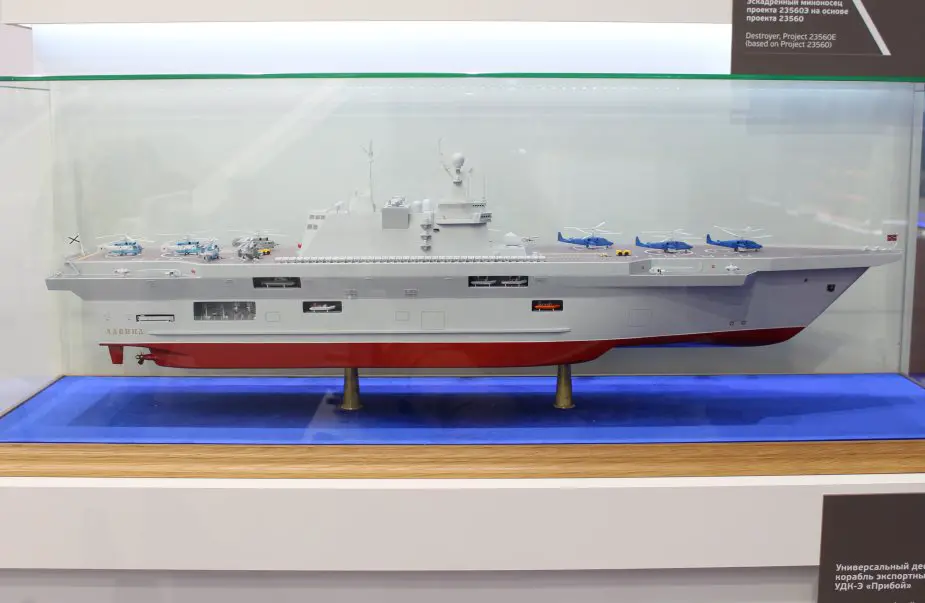Russian media have recently reported the characteristics of prospective amphibious assault ships which are to be laid in the spring of 2020. They show that the Russian Navy will obtain, although with a delay, universal landing ships for ship-to-shore connection. Profile magazine writes about their characteristics and design.
 Priboy LHD scale model showcased by Krylov during Army 2016 exhibition (Picture source: Navy Recognition)
Priboy LHD scale model showcased by Krylov during Army 2016 exhibition (Picture source: Navy Recognition)
The composition and strength of airpower is a key issue. The available naval Ka-27 antisubmarine and rescue helicopters, as well as Ka-29 transport and Ka-31 radar surveillance helicopters, cannot effectively fulfil the airpower missions of a universal amphibious assault ship because of insufficient flight and technical characteristics. There is also the shipborne Ka-52 known as Ka-52K. However, one attack helicopter is insufficient for the airpower of a universal landing ship.
At present Russia is designing a new family of multirole seaborne helicopters under Minoga codename which are sometimes identified as Ka-65. The exact characteristics of the vehicle are not disclosed, but available data provide for some conclusions.
In particular, prospective seaborne helicopters will have two TV7-117 engines with a takeoff capacity of 3000 HP and boost the capacity of 3750 HP. TV7-117 powers multirole Mi-38.
The project to design a seaborne helicopter with such engines began yet in 1991 in Soviet time. The new vehicle Ka-40 had to have a takeoff weight of close to 15 tons. If there is any succession of Ka-40 in Ka-65, the takeoff weight is likely to be the same.
The capacity and takeoff weight show that Minoga corresponds to Mi-38 or multirole AW-101 helicopter.
A helicopter with a takeoff weight of over 20 tons is likely to appear in future and reinforce the airpower. However, 20 Ka-65 are sufficient to land a marine battalion with infantry support weapons (mortars, automatic grenade launchers, large-calibre machineguns, antitank missiles) and light artillery. Armour, automobiles, heavy artillery are to be delivered by landing boats.
The amphibious assault concept in the Russian Navy was formed by the results of two world wars. 1. Amphibious assault is held to support ground forces on the coast. 2. The scope of amphibious assault depends, firstly, on the needs of the army in support from the coastal flank, and secondly, on the range of coastal aviation which has to protect the assault and support it, and thirdly, on fleet capabilities to escort an assault formation and form a group of fire support warships. 3. The scope of marine operations is not big and limited by the tactical level (brigade). Ground forces increase the strength, if necessary. The formations arrive on usual transportation means in the seaports seized by the first echelon. Airborne units can be used as reinforcements.
The subordination to army interests automatically boiled down the role of the Navy to planning of operations in support of the ground forces. The need to have expeditionary forces capable of limited amphibious assault at a major distance from the bases has not been considered for decades. The issue came to attention in the last years of the Soviet Union when the design of universal landing ships of project 11780 was launched in the framework of the concept which shaped out in the West by the time.
© Copyright 2019 TASS. All rights reserved. This material may not be published, broadcast, rewritten or redistributed.



